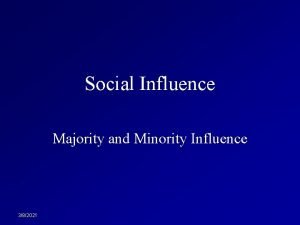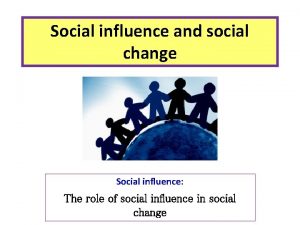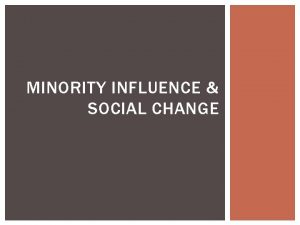Social Influence Implications for Social Change Implications for













- Slides: 13

Social Influence Implications for Social Change

Implications for Social Change when an individual's thoughts or actions are affected by other people. Social influence takes many forms and can be seen in conformity, socialization, peer pressure, obedience, leadership, persuasion, sales, and marketing. What’s the difference? when social mechanisms regulate individual and group behaviour, leading to conformity and compliances to the rules of a given society or social group. when a whole society adopts a new belief or way of behaving which then becomes widely accepted as the ‘norm’

Social Change From what we have studied so far we have seen social influence research as a form of social control and not social change. Social change is when a society adopts a new belief or way of behaving which then becomes accepted as the norm. Social influence doesn’t just tell us about how individuals might change their behaviour, it can also inform us about how societies might change. If we think about historical events there is evidence of social influence in many forms of social change. For example, Mahatma Ghandi’s dissent against the British salt tax in India acted as a catalyst for widespread social reform.

“We find evidence of social influence in many different types of social change” Cardwell & Flanagan

“We find evidence of social influence in many different types of social change” Cardwell & Flanagan

Video You will soon be able to answer the following questions: How did the minority influence social change? What were the implications for social change after the incident on the bus on December 1 st 1955? Rosa Parks

Implications of Conformity Research When a minority gains enough supporters they become the majority. The old majority then becomes the minority. Prislin and Christensen (2002) reviewed studies in this area and concluded …that losing the majority position can decrease satisfaction and increase hostility along with the desire to exit the group. A real-life example of this is the increase in emigration from South Africa in the aftermath of social change. A newly powerful black South African government led to little improvement in people’s lives, and the newly powerless white South African minority reported significant deterioration.

So how do they do it? Drawing attention to an issue Minorities can draw our attention to the issues being addressed. If the views are different to the majority then a conflict is created, which the majority is motivated to reduce. The image on the rights shows ‘Fathers 4 Justice’, a group which dress in costumes to bring attention to the issues of fathers’ rights after divorce.

How else? The role of conflict We cannot simply think of a minority as being ‘different’. Sometimes we will analyse their argument more closely. This doesn’t always result in us changing our opinions, but imagine that you are given information on animal testing and cosmetics. After reading the leaflet you may accept that animal testing is wrong, you may then buy products not tested on animals, and ultimately your behaviour has changed. This is social change. Consistency In order to be successful a minority must be consistent over time and with each other, this helps them to be taken more seriously. Wood et al. (1994) carried out a meta-analysis of 97 studies and found that a consistent minority is most influential.

And finally. . . The augmentation principle This states that if there is a risk when putting forward your point of view then you will be taken more seriously. This is because the minority is willing to suffer in order for the views to be increased (or augmented) and then is more likely to influence social change. Publicly the views of the minority can oppose the majority, leading to jail or even death. An example of this can be found in a Polish trade union called ‘Solidarity’. They stood up for workers’ rights, against government censorship, intimidation and imprisonment. Solidarity grew and led to over 10 million members, who eventually overthrew the communist government in 1989.

Implications of Social Change Research You might be wondering how obedience is related to social change. Milgram’s research suggested that although the majority of people might find it difficult to resist authority, this is not always the case, and there are circumstances where people can and do resist obedience.

Evaluation task Create a revision mind map about the evaluation of social change. You must include. . . The Suffragettes Why a minority doesn’t always lead to social change How minority influence can help us to understand terrorism Again, remember that for the exam it is very important that you do not get carried away with the ‘real-life’ examples of social change, e. g. Ghandi and Rosa Parks. You must have psychological evidence to support your answer.

Practice Question What are the implications for social change of research into social influence? [6 marks] Mark Scheme
 Social thinking social influence social relations
Social thinking social influence social relations Social thinking social influence social relations
Social thinking social influence social relations Social thinking and social influence
Social thinking and social influence Social thinking theories
Social thinking theories Legal implications of social media
Legal implications of social media Social implications of computers
Social implications of computers Social work: an empowering profession 9th edition chapter 1
Social work: an empowering profession 9th edition chapter 1 Normative social influence
Normative social influence Conversion social influence example
Conversion social influence example Informational social influence example
Informational social influence example Examples of informational social influence
Examples of informational social influence Societal norms examples
Societal norms examples Passivity
Passivity Group dynamics communication and interaction patterns
Group dynamics communication and interaction patterns

























